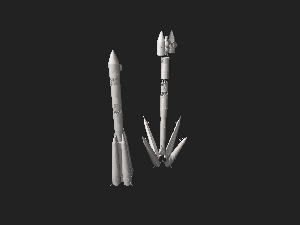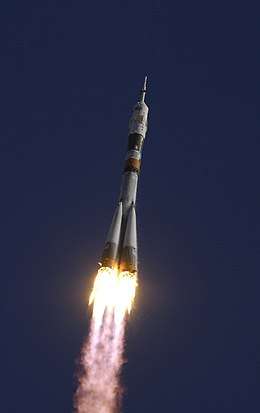Voskhod (rocket)
The Voskhod rocket (Russian: Восход, "ascent", "dawn") was a derivative of the Soviet R-7 ICBM designed for the human spaceflight programme but later used for launching Zenit reconnaissance satellites.[1][2] It consisted of the Molniya 8K78M third stage minus the Blok L.[3] In 1966, all R-7 variants were equipped with the uprated core stage and strap-ons of the Soyuz 11A511. The Blok I stage in the Voskhod booster used the RD-107 engine rather than the RD-110 in the Soyuz, which was more powerful and also crew-rated. The sole exception to this were the two manned Voskhod launches, which had RD-108 engines, a crew-rated RD-107 but with the same performance.
 Voskhod rocket | |
| Function | Crew-rated LEO carrier rocket |
|---|---|
| Manufacturer | OKB-1 |
| Country of origin | Soviet Union |
| Size | |
| Height | 30.84 m (101.2 ft) |
| Diameter | 2.99 m (9.8 ft) |
| Mass | 298,400 kg (657,900 lb) |
| Stages | 2 |
| Capacity | |
| Payload to LEO | 5,900 kg (13,000 lb) |
| Associated rockets | |
| Family | R-7 |
| Launch history | |
| Status | Retired |
| Launch sites | Baikonur Site 1 and Site 31 Plesetsk, Site 41 |
| Total launches | 300 |
| Successes | 287 |
| Failures | 13 |
| First flight | 16 November 1963 |
| Last flight | 29 June 1976 |
| Notable payloads | Voskhod spacecraft Zenit (satellite) |
| Boosters | |
| No. boosters | 4 |
| Engines | 1 RD-107-8D74K |
| Thrust | 995.4 kN (223,800 lbf) |
| Total thrust | 3,981.6 kN (895,100 lbf) |
| Specific impulse | 257 seconds (2.52 km/s) |
| Burn time | 119 seconds |
| Fuel | RP-1 / LOX |
| First stage | |
| Engines | 1 RD-107-8D75K |
| Thrust | 941 kN (212,000 lbf) |
| Specific impulse | 248 seconds (2.43 km/s) |
| Burn time | 301 seconds |
| Fuel | RP-1 / LOX |
| Second stage | |
| Engines | 1 RD-0108 |
| Thrust | 294 kN (66,000 lbf) |
| Specific impulse | 330 seconds (3.2 km/s) |
| Burn time | 240 seconds |
| Fuel | RP-1 / LOX |
All 11A57s launched after 1965 were functionally a 11A511 without the Soyuz's payload shroud and launch escape system (with the exception of the third stage propulsion system as noted above). Around 300 were flown from Baikonur and Plesetsk through 1976 (various payloads, but Zenith IMINT satellites were the most common). The newer 11A511U core had been introduced in 1973, but the existing stock of 11A57s took another three years to use up.
See also
References
- Barensky, C. Lardier, Stefan (2013). The Soyuz launch vehicle the two lives of an engineering triumph. New York: Springer. p. 160. ISBN 978-1-4614-5459-5.
- Hall, Rex; Shayler, David J. (2001). The rocket men : Vostok & Voskhod, the first Soviet manned spaceflights. London [u.a.]: Springer [u.a.] p. 226. ISBN 978-1-85233-391-1.
- Kruse, Richard. "Historic Spacecraft - Soviet and Russian Rockets". HistoricSpacecraft.com. Historic Spacecraft. Retrieved 19 July 2014.

